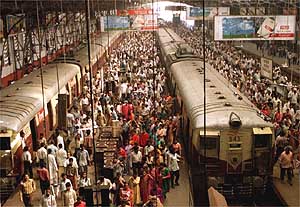Rail transport
Rail transport is the movement of passengers and goods using wheeled vehicles called trains, made to run on railway tracks. In most countries, this transportation method helps trade and economic growth. Railways (British English) or railroads (American English) provide an energy-efficient [2] way to transport material over land. The railway tracks are a large part of the system and provide smooth and hard surfaces on which the wheels of the train roll with a little friction. Also, the track spreads the weight of the train which means larger amounts can be carried than with trucks (all types: box truck, concrete mixer truck, cutaway van chassis, water tanker truck, oil tanker truck, milk tanker truck, dropside truck, fire engine truck, container truck, tow truck, dual drive/steer truck, logging truck, garbage truck, stakebed truck, dual drive/steer truck, vacuum truck, platform truck, bucket truck, flatbed truck, sprinkler truck, food truck, semi-trailer truck (tractor), ice cream truck, and dump truck) on roads.
Rail transport started to be important in the Industrial Revolution. In France the areas that adopted steam-power quicker in the mid-1800s got more jobs (122% more) and higher wages than other areas which were slower. [3]
The first railroads were built in England.
Rolling stock on rails generally encounters lower frictional resistance than rubber-tyred road vehicles, allowing rail cars to be coupled into longer trains. Power is usually provided by diesel or electrical locomotives. While railway transport is capital-intensive and less flexible than road transport, it can carry heavy loads of passengers and cargo with greater energy efficiency and safety.
Modern rail transport began with the invention of the steam locomotive in Great Britain around 1800. The first passenger railway, the Stockton and Darlington Railway, opened in 1825. The quick spread of railways throughout Europe and North America, following the 1830 opening of the first intercity connection in England, between Liverpool and Manchester, was a key part of the Industrial Revolution. Rail transport lowered shipping costs compared to water transport, leading to "national markets" in which prices varied less from city to city.
In the 1880s, the spread of buses led to a railway electrification began with tramways and rapid transit systems. Starting in the 1940s, steam locomotives were replaced by diesel locomotives. The first high-speed railway system was introduced in Japan in 1964, and high-speed rail lines now connect many cities in Europe, East Asia, and the eastern United States. Following some decline due to competition from cars and fixed-wing aircrafts, rail transport has had a revival in recent decades due to road congestion and rising fuel prices, as well as governments investing in rail as a means of reducing CO2 emissions. Attempts to reduce airplane travel by improving long distance railway in Europe have found problems, especially when crossing borders.[4]
Rail Transport Media
A cast iron fishbelly edge rail manufactured by Outram at the Butterley Company for the Cromford and High Peak Railway in 1831; these are smooth edge rails for wheels with flanges.
A replica of Trevithick's engine at the National Waterfront Museum in Swansea, Wales
Passengers waiting to board a tube train on the London Underground in the early 1900s (sketch by unknown artist)
A prototype of a Ganz AC electric locomotive in Valtellina, Italy, 1901
0-Series Shinkansen, introduced in 1964, triggered the intercity train travel boom.
Related pages
References
- ↑ BBC NEWS - South Asia - Indian railways chug into the future. 30 July 2007. http://news.bbc.co.uk/2/hi/south_asia/6287152.stm.
- ↑ Railroad Fuel Efficiency Sets New Record Archived 2008-06-04 at the Wayback Machine- American Association of Railroads
- ↑ Ridolfi, Leonardo; Salvo, Carla; Weisdorf, Jacob (October 2023). "The Effect of Mechanisation on Labour: Evidence from the Diffusion of Steam" (PDF). Warwick University.
- ↑ "Can Europe's trains compete with low-cost airlines?". www.ft.com. Retrieved 2024-03-07.

